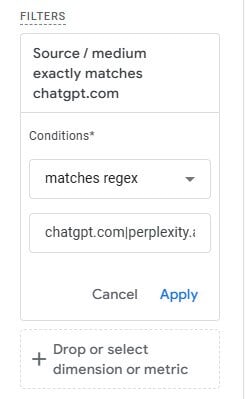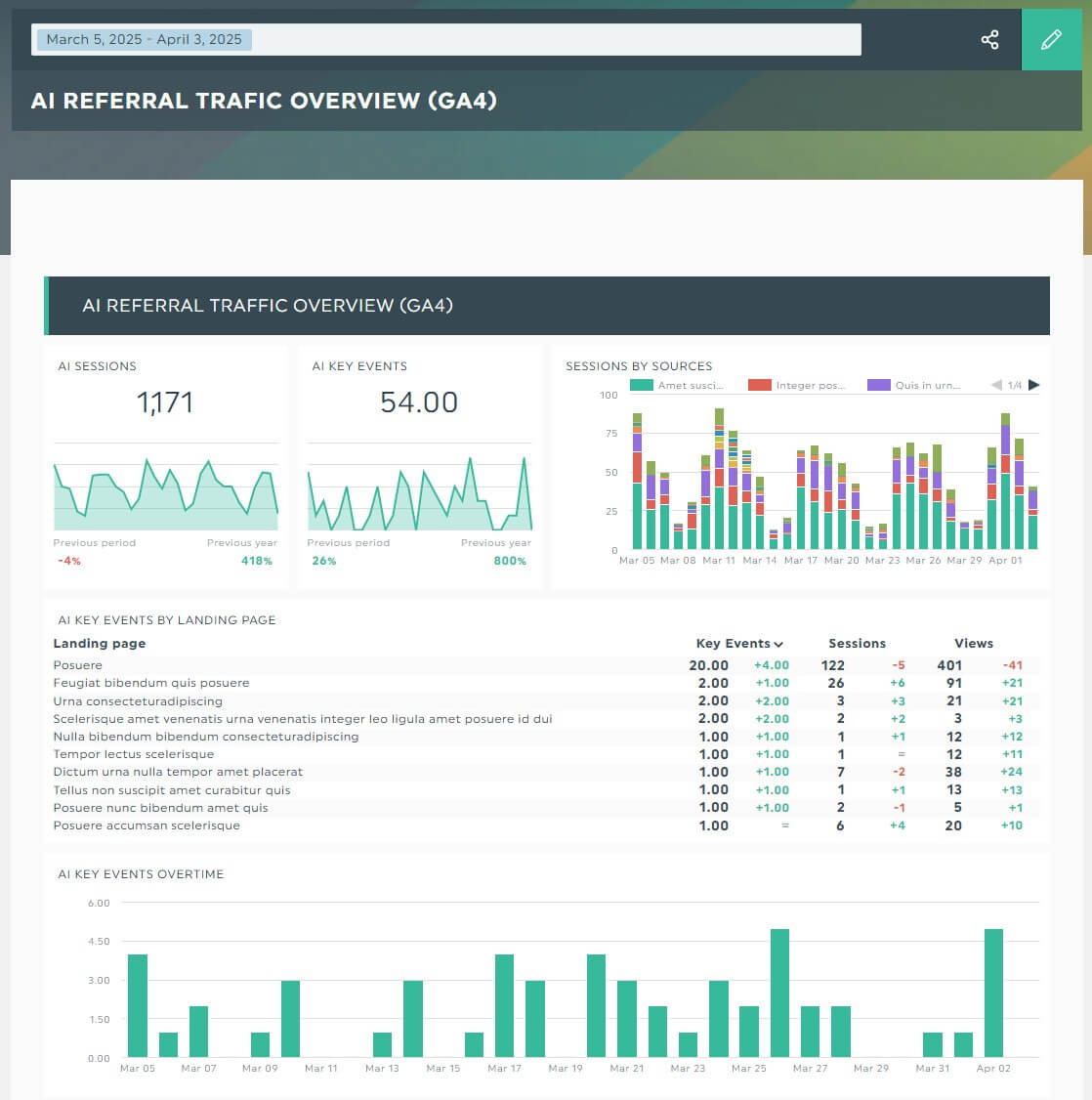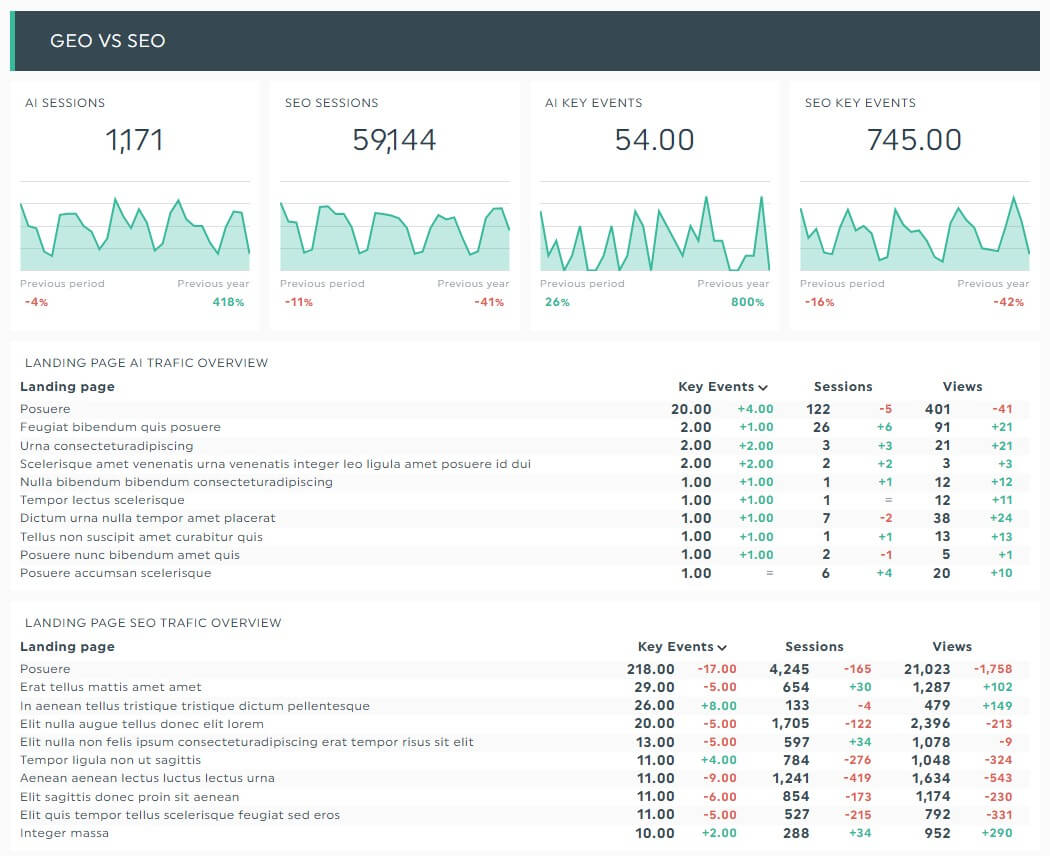How to Track AI Referral Traffic on GA4 (Free Template)

You know it's time to take artificial intelligence (AI) seriously when it drove a record number of visitors, sessions, and conversions to your site.
By tracking your content's performance across major AI platforms, you gain a clearer picture of your brand perception, increase visibility, and identify which LLMs deliver the highest-value customers.
This guide shows you how to track your AI referral traffic on Google Analytics (GA) 4, and recommends how you can measure it automatically.
- What is AI Referral Traffic in GA4 (And How to Find It?)
- How to Track AI Referral Traffic on DashThis Automatically
- Automate Your GA4 Reporting with DashThis
What is AI Referral Traffic in GA4 (And How to Find It?)
AI referral traffic refers to your website traffic visits from AI search tools, platforms, or tools like ChatGPT Search, Perplexity AI, Claude, and Google AI Overview.
Other popular AI sources include Microsoft Copilot, Waldo, You.com, and Brave Search.
💡WHY SHOULD DIGITAL MARKETING PROFESSIONALS TRACK TRAFFIC FROM AI SEARCH ENGINES?
Tracking your site traffic from AI chatbots help you understand how these emerging channels drive high-intent visitors, sessions, and conversions.
This way, you can:
(i) Boost your visibility across multiple large language models (LLMs)
More on-platform mentions improve your brand awareness and positive brand sentiment, leading to steady organic traffic and conversions.
(ii) Ensure you're not over-investing in building your AI traffic
Despite Google search driving 345x more search traffic than OpenAI's ChatGPT, Perplexity, and Gemini combined, AI traffic is growing as a referral source.
Tally, an online form builder, saw a record of 12,000 new users in one week alone (!), proving that AI tools are changing how brands are discovered.

As you identify your top-performing posts, analyze whether most of your traffic comes from traditional or AI search engines. This will help you determine if you should focus on SEO or AI optimization tactics.
And while you're at it, analyze which LLMs perform best from a conversion standpoint.
🧭 HOW TO IDENTIFY AI-GENERATED TRAFFIC IN GOOGLE ANALYTICS 4 (GA4)?
Here's an easy way to measure AI referral traffic on GA4:
- Log in to your GA4 account
- Click Explore
- Select a blank exploration report

Under the Variables tab, give the Exploration a new name (e.g., AI Referral Traffic). Input the date range accordingly.
Under Dimensions, select Source / medium. Tip: Add Landing page to track specific posts or pages cited on AI search engines.
Next, select Sessions, Active users, and Engagement rate under Metrics. Add more GA4 metrics if needed (e.g., Key events).

Click Settings at the bottom left.
Scroll down to Filters. Click Drop or select dimension or metric > Source / medium. Click matches regex in the dropdown menu and in the field Enter expression, input the AI search engine URLs (e.g., chatgpt.com|perplexity.ai|copilot.microsoft.com|waldo.fyi).
Add more AI search engines as you like.
Click Apply.

And that's it!
Sit back and let GA4 work its magic.
There are more ways to track AI search engine traffic — the Exploration Report is just one of them. Other methods on GA4 include Page Referrer Filter and Custom Channel Group in your acquisition report.
These manual methods require navigating a dozen steps and untangling fragmented data sets that can consume hours of your week. For a solution that saves your time, continue to the next section.
How to Track AI Referral Traffic on DashThis Automatically
DashThis is the easiest reporting tool.
Automatically gather all your data from multiple Google Analytics accounts and sources into one report.
🤩 There's no metrics or dimensions restriction on DashThis! Grab all your site performance, including SEO, PPC, and AI efforts — all in one place.
Here's how automating an AI-focused GA4 report on DashThis looks like:
🎥 Prefer watching instead? Check out this video walkthrough of how to set up your AI traffic report in DashThis:
1. Select the free GA4 report template
2. Connect your GA4 account with DashThis (you can also connect other marketing channels like LinkedIn, Reddit Ads, and Pinterest)
3. Pick your metrics in Preset Widgets (note: if you don't see the metric, click Custom Widget, select a graph type, and pick the metric, dimension, and filter(s)).
Hang tight while DashThis gathers the data into your dashboard automatically. Drag and drop the metrics as desired.
You'll end up with a report similar to the one below. Note how you can analyze your session source data and everything else at a glance.

Grab this free AI referral traffic report with your own data!
Customize the dashboard. You can:
- Add built-in notes (Hover over a metric, click Add Note > Save)
- Upload your company or client's logo
- Edit the color themes to reflect your brand
- ...and more
Here are some ideas to illustrate our point.
But first, let's get the confusion out of the way...
GEO vs SEO
Generative engine optimization (GEO) is the process of improving your content for AI search engine algorithms.
The more in-depth, readable, and comprehensive your content is to the searcher's query, the more AI platforms will spotlight it as the definitive answer — putting your brand front and center.
This is slightly different from SEO.
Unlike GEO, SEO drives organic traffic to your website by boosting visibility on search engine result pages (SERPs) in traditional engines like Google and Bing. Its performance hinges on metrics like backlinks, domain authority, and keyword density.
💡 WHAT'S THE IMPACT OF AI TRAFFIC ON SEO?
AI-driven responses provide answers directly on the results page, causing users to skip clicking through to websites. This has drastically slashed click-through rates (CTRs), even for previously top-ranking sites.
However, that's not to say you should give up on SEO entirely.
It just means pivoting from keywords vulnerable to "zero click" answers (e.g., "what is omnichannel marketing?") toward creating unique, experience-backed content.
Basically, deep-dive content that compels users to click through for answers to their complex follow-up questions and nuanced scenarios (tip: conduct customer research to unearth their fears, desires, and challenges).
🤔 SO HOW DO YOU CUSTOMIZE YOUR REPORT?
If stakeholders question your strategy, highlight the impact of GEO and SEO in your GA4 dashboard. Note how the report below makes a compelling case for continued SEO investment — the dramatic differences in Sessions, Key Events, and Views demonstrate SEO as a high-performing channel.

GEO vs PPC traffic
Pay-per-click (PPC) is a paid advertisement where you pay search engines or social media platforms for every click on your ad.
💡 WHAT'S THE IMPACT OF AI TRAFFIC ON PPC?
While comprehensive data on AI traffic's impact on PPC remains limited, recent Perplexity reports signal a fundamental shift in targeting strategy.
Instead of targeting consumers through PPC ads, brands will compete for AI agents' attention, hinting that traditional metrics like impressions and CTRs will become less important.
Whether you want to gauge the performance of your PPC ads or GEO efforts, this report comes in handy. The impact of GEO vs. SEO spotlights which channel drives more valuable traffic to your site.

As demonstrated above, PPC boasts a slight edge over AI.
Here's another way to customize your report.
After populating the report with your most important metrics, add a comment box to share strategic recommendations clients can implement immediately.
For example, if you want to explain the correlation between keyword rankings and mentions on AI platforms, click Static Widget > Comment.

Explain your findings.
Click Save.
After customizing your report, schedule an automatic email dispatch:
- Hover over the Sharing Options icon in the top right
- Click Share by Email
- Set the dashboard period and frequency
- Add an optional note
- Click Schedule
This lets you send the report on a pre-determined schedule. Anyone who receives it can view it in real-time.

Now you no longer need to deal with endless email threads. Analysis, client education, and report distribution — you can do everything on DashThis in one place.
Automate Your GA4 Reporting with DashThis
Before you get carried away by the AI hype and denounce SEO, track how much of your site traffic, sessions, and conversions come from bots and AI search platforms like SearchGPT.
It'll help you allocate resources for your GEO efforts based on actual revenue impact.
The sooner you track it, the faster you stay ahead of your brand’s AI search presence, improve visibility, and increase your chances of being chosen.
Better yet, track your AI referral traffic automatically.
DashThis is the easiest reporting tool that automatically pulls your entire Google Analytics data from multiple accounts and sources into one beautiful report. Start your free 15-day trial today.
Ready to track your Search AI Traffic?
Read More
Don’t miss out!
Automate your reports!
Bring all your marketing data into one automated report.
Try dashthis for free

